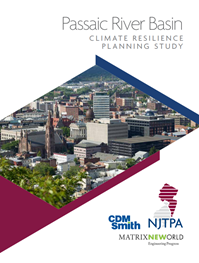
The chronic flooding in the Passaic River Basin, home to some 2.5 million people, is likely to get worse as a result of climate change, raising serious threats to homes, businesses and the area’s heavily used transportation system. That is a key conclusion of a major study sponsored by the NJTPA which sought to assess the threats and find solutions.
Encompassing parts of eight New Jersey counties and extending into New York State, the basin is centered on the Passaic River and its tributaries. Since 1900, at least 26 lives have been lost in floods in the basin, with property losses of $5.5 billion. An April 2007 flood resulted in over 5,000 people being evacuated and major storms in recent years have also taken their toll.
The Passaic River Basin Climate Resilience Planning Study projected the occurrence of extreme heat events and extreme precipitation events for two horizon years: 2045 and 2080. The projections found that areas adjacent to the region’s waterways — already prone to flooding — could face more frequent and more severe storms. In 2045, the annual chance of a storm producing 9.1 inches of precipitation over 4 days is approximately twice as likely as today. This, coupled with continued development in the areas, the report says, “increases the likelihood of future property losses, threatens the economic stability of communities, and puts public health and safety at risk.”
At least 10 percent of the 3,245 transportation assets evaluated in the basin were determined to be “highly vulnerable to existing and future heat and/or floods events.” This includes bridges, culverts, rail, roads including bus routes, and transit rolling stock.
In consultation with a technical advisory committee, which included representatives of the eight area counties and state agencies, 71 adaptation strategies were developed to safeguard infrastructure and address the threats. Among the recommendations was to, “Use the vulnerability assessment findings in current and future planning and design studies to inform the siting of new infrastructure and updates and improvements to existing infrastructure.” Further data collection, modeling and regionwide coordination were also called for.
The final report and several appendices are
available for download at the NJTPA website.